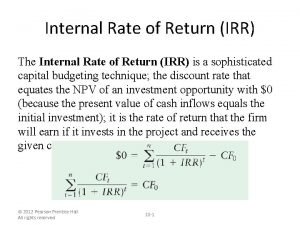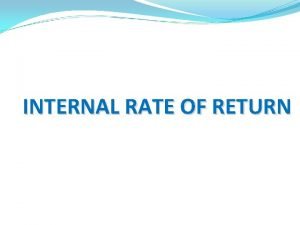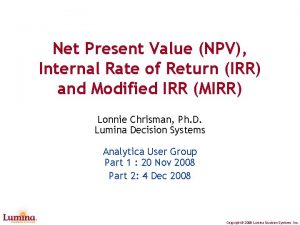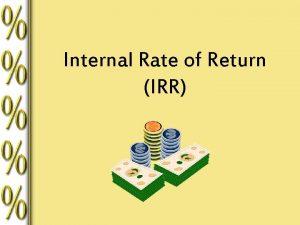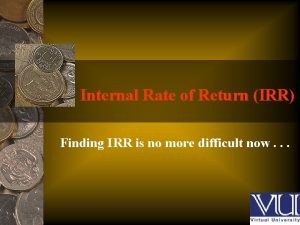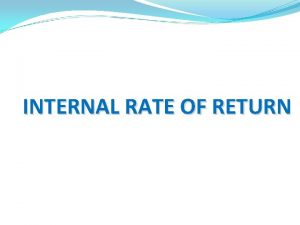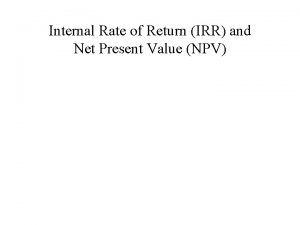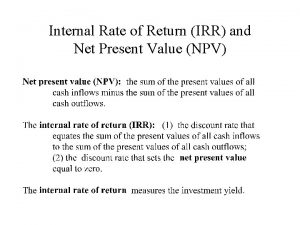Internal Rate of Return IRR The Internal Rate









- Slides: 9

Internal Rate of Return (IRR) The Internal Rate of Return (IRR) is a sophisticated capital budgeting technique; the discount rate that equates the NPV of an investment opportunity with $0 (because the present value of cash inflows equals the initial investment); it is the rate of return that the firm will earn if it invests in the project and receives the given cash inflows. © 2012 Pearson Prentice Hall. All rights reserved. 10 -1

Internal Rate of Return (IRR) Decision criteria: – If the IRR is greater than the cost of capital, accept the project. – If the IRR is less than the cost of capital, reject the project. These criteria guarantee that the firm will earn at least its required return. Such an outcome should increase the market value of the firm and, therefore, the wealth of its owners. © 2012 Pearson Prentice Hall. All rights reserved. 10 -2

Figure 10. 3 a Calculation of IRRs for Bennett Company’s Capital Expenditure Alternatives © 2012 Pearson Prentice Hall. All rights reserved. 10 -3

Figure 10. 3 Calculation of IRRs for Bennett Company’s Capital Expenditure Alternatives © 2012 Pearson Prentice Hall. All rights reserved. 10 -4

Internal Rate of Return (IRR): Calculating the IRR (cont. ) • To find the IRR using the preprogrammed function in a financial calculator, the keystrokes for each project are the same as those for the NPV calculation, except that the last two NPV keystrokes (punching I and then NPV) are replaced by a single IRR keystroke. • Comparing the IRRs of projects A and B given in Figure 10. 3 to Bennett Company’s 10% cost of capital, we can see that both projects are acceptable because – IRRA = 19. 9% > 10. 0% cost of capital – IRRB = 21. 7% > 10. 0% cost of capital • Comparing the two projects’ IRRs, we would prefer project B over project A because IRRB = 21. 7% > IRRA = 19. 9%. © 2012 Pearson Prentice Hall. All rights reserved. 10 -5

Internal Rate of Return (IRR): Calculating the IRR (cont. ) © 2012 Pearson Prentice Hall. All rights reserved. 10 -6

Internal Rate of Return (IRR): Calculating the IRR (cont. ) • It is interesting to note in the preceding example that the IRR suggests that project B, which has an IRR of 21. 7%, is preferable to project A, which has an IRR of 19. 9%. • This conflicts with the NPV rankings obtained in an earlier example. • Such conflicts are not unusual. • There is no guarantee that NPV and IRR will rank projects in the same order. However, both methods should reach the same conclusion about the acceptability or nonacceptability of projects. © 2012 Pearson Prentice Hall. All rights reserved. 10 -7

Personal Finance Example Tony Di. Lorenzo is evaluating an investment opportunity. He feels that this investment must earn a minimum compound annual after-tax return of 9% in order to be acceptable. Tony’s initial investment would be $7, 500, and he expects to receive annual after-tax cash flows of $500 per year in each of the first 4 years, followed by $700 per year at the end of years 5 through 8. He plans to sell the investment at the end of year 8 and net $9, 000, after taxes. – Tony finds the investment’s IRR of 9. 54%. – Given that the expected IRR of 9. 54% exceeds Tony’s required minimum IRR of 9%, the investment is acceptable. © 2012 Pearson Prentice Hall. All rights reserved. 10 -8

Comparing NPV and IRR Techniques: Net Present Value Profiles Net present value profiles are graphs that depict a project’s NPVs for various discount rates. To prepare NPV profiles for Bennett Company’s projects A and B, the first step is to develop a number of discount rate-NPV coordinates and then graph them as shown in the following table and figure. © 2012 Pearson Prentice Hall. All rights reserved. 10 -9
